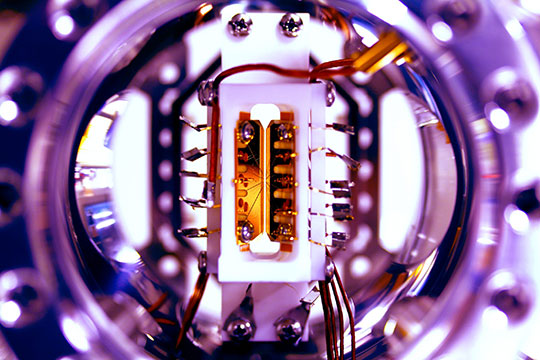 (S. Debnath and E. Edwards/JQI)
(S. Debnath and E. Edwards/JQI)
ALEXANDRIA, Va. — It’s only a matter of time before a quantum computer is developed with the number of physical qubits required to render current public key encryption obsolete.
The nightmare scenario of “Q-Day” is not the sci-fi fantasy it was in the early 1990s. The most cautious experts believe a quantum computer could be developed by 2025 that’s powerful enough to break a 2048-bit RSA key in a matter of hours—a feat that would take trillions of years for a conventional supercomputer. Most experts expect to reach a critical point in 15 years, according to the latest Quantum Threat Timeline Report.
“Some of the scary stories, unfortunately, those are real,” said Chune Yang Lum, CEO of SpeQtral, a Singapore-based company working on satellite-based quantum key distribution (QKD). That a large enough quantum computer will eventually break RSA encryption is “grounded in fact and in physics theory.”
SpeQtral’s recommendation: don’t wait. Governments, agencies and entities with very low cybersecurity risk tolerance should start thinking about migrating to quantum encryption sooner than later. For organizations with a global footprint, satellite-based QKD can assure essentially hack-proof communications.
“It’s inherently required and necessary to start thinking about being quantum secure,” Lum said. “So, think about how to start early, how to migrate and how to plan forward.”
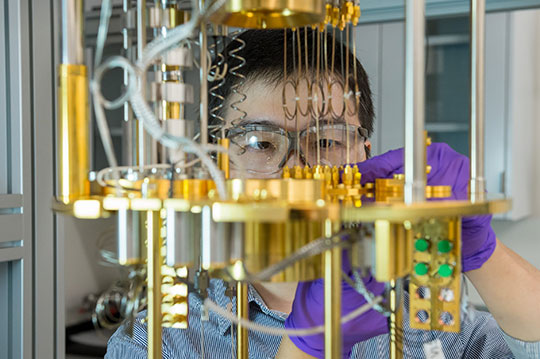 (Argonne National Laboratory)
(Argonne National Laboratory)
Investments in quantum computing breakthroughs are accelerating around the world. At the same time, migration for cybersecurity systems can take years, especially for large organizations. Post-quantum cryptography and quantum-resistant algorithms will be part of the new security architecture, particularly in the near term. However, quantum encryption, or QKD, remains the only security tool available today to fight quantum with quantum.
As the technology matures, QKD is expected to provide an added layer of security on top of existing stacks. Organizations will need to install optical ground station equipment, but won’t have to fundamentally change their security infrastructure, according to Lum.
QKD in a Nutshell
QKD exploits the quantum properties of light to generate secure random keys that are impossible to intercept. The methods for generating and delivering the keys fall into two schemes or protocols. In the prepare and measure protocol, photons are assigned binary encoding based on polarization, phase, position and other degrees of freedom and distributed between locations. That string of photons are used to generate symmetric keys between the sender and receiver. Any attempt to intercept or observe the photons in transit will compromise the link and be detectable.
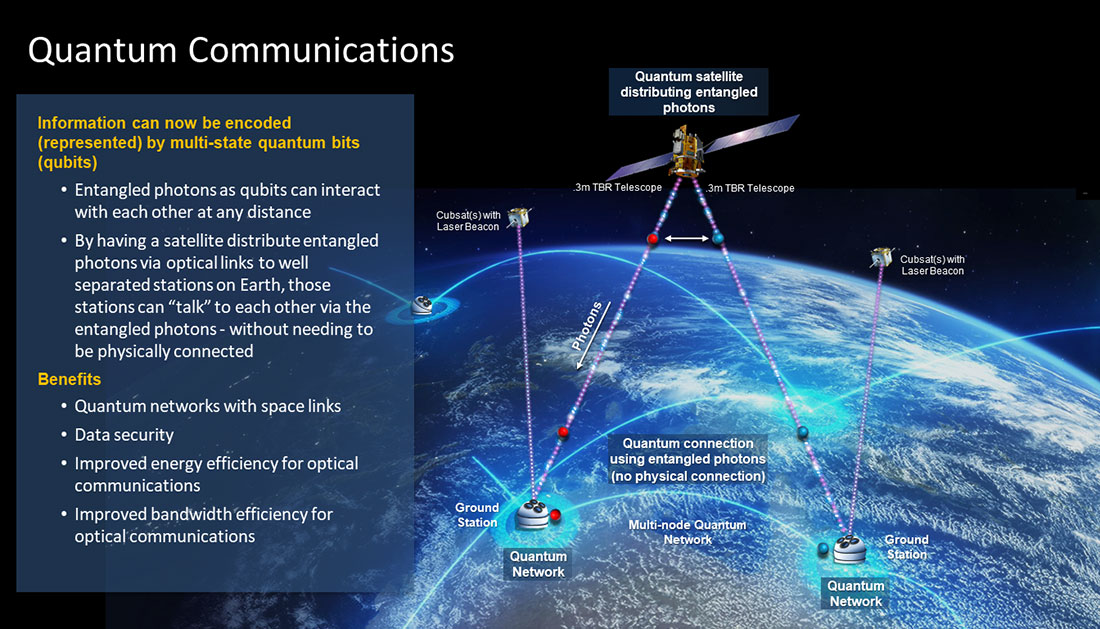 Illustration of satellite-based quantum entanglement. (NASA)
Illustration of satellite-based quantum entanglement. (NASA)
Entanglement protocols exploit quantum entanglement to generate truly random keys without encoding photons. In this scheme, pairs of entangled photons are created at a source and sent to different locations where users receive symmetric keys by following the protocol. Interception or eavesdropping will break entanglement.
Currently, China, the U.K., U.S., Canada, Singapore, Japan and South Korea have metro-based terrestrial QKD networks that can generate and transmit keys across short distances connected by fiber-optic cable. Covering distances greater than 100km requires a network of secure repeating stations, or trusted nodes, which is not practical or affordable for inter-continental or global QKD distribution.
Free space transmission from satellites, though still early in development, is currently the only practical means for distributing quantum keys on a global basis.
Demonstrated Capabilities and Ongoing Challenges
A growing number of countries and companies are advancing QKD, though only a handful are focused on space-based application.
SpeQtral is one of two companies to demonstrate quantum entanglement payloads in space—China’s CAS Quantum Network is the other. SpeQtral plans to launch its second satellite, SpeQtral-1, in 2024 to demonstrate commercial end-to-end quantum key distribution. Other companies with a space-quantum focus include Canada’s QeyNet and the UK’s ArQit, which recently partnered with BT (British Telecom) to provide satellite and terrestrial quantum security solutions.
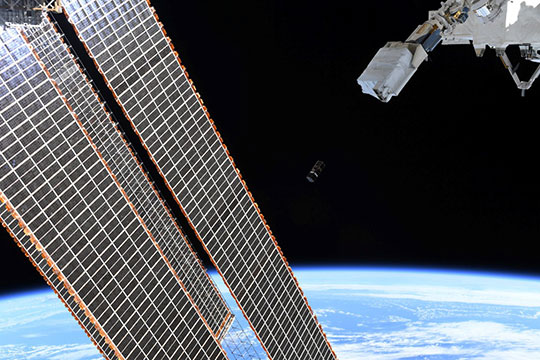 SpooQy-1 (center), launched in 2019 by Singapore’s Centre for Quantum Technology deployed. (NASA)
SpooQy-1 (center), launched in 2019 by Singapore’s Centre for Quantum Technology deployed. (NASA)
China, Japan, Singapore and India have demonstrated quantum communications from space. Several other countries, including Canada, the U.K., Australia and the United States are actively developing space capabilities in addition to their terrestrial quantum security demonstrations.
“It’s tough. It’s really tough,” Dr. Mark Adams, assistant professor at Auburn University recently told Constellations at the 2022 SmallSat Conference. Adams is one of the leaders of Auburn’s Quantum Encrypted Satellite-Based Transmission (QUEST) program, a collaboration with the U.S. Air Force Research Lab to demonstrate QKD capabilities from a 12-U CubeSat. The goal, according to Adams, is to launch the demonstrator by 2025 and pave the way for a low Earth constellation providing global quantum-secured communication coverage.
The technical hurdles associated with satellite-based QKD remain high. Pointing requirements for QKD space-to-ground links are more stringent than optical communications systems. Like optical communication, they must overcome atmospheric attenuators like rain and fog. Additionally, manipulating quantum properties to build a reliable QKD system requires a high level of expertise. Then those systems must be miniaturized and built to withstand space environment.
The Global ‘Quantum Race’
2016 was a wake-up call for those who believed space-based quantum communication was still a distant prospect. That August, China’s Micius satellite was the first to demonstrate point-to-point intercontinental QKD.
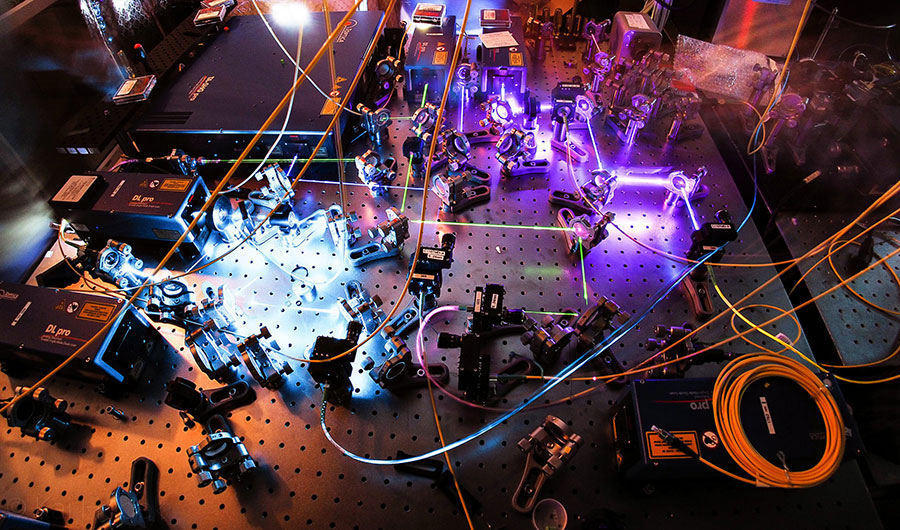 (J. Consoli/UMD)
(J. Consoli/UMD)
Many people were “caught…on a back foot,” said Adams. “They definitely showed that they were a little bit further ahead in some of the spaceborne technologies for quantum communication.”
Increasingly, nations and private investors have been eagerly fueling quantum research. According to a report by McKinsey & Company, the United Kingdom, United States, Japan and India have each invested over US$1 billion to advance quantum technology and quantum computing. The European Union has planned $7.2 billion in government funding for quantum, with Germany, France, the Netherlands and Sweden leading the way. Singapore, South Korea, Canada, Israel and Russia have smaller national programs. China has outspent every other nation in spending an estimated $15 billion.
Whether it’s called a “quantum race” or the “race for quantum supremacy,” there is a high-stakes global competition to be first and best in a technology that will likely be the future foundation for computing, secure communications and untold other applications.
“There’s uncertainty about who or when someone will deliver a large enough quantum computer to hack these encryptions,” Lum said. “That element of uncertainty is what drives the need to look at this technology, to speed up the adoption and to think about quantum security.”
Explore More:
Quantum Communications in Space: A Deeper Dive
Podcast: ‘Spooky’ Quantum Entanglement and Applications in Space
Laser Terminal Are Shaking Up Space Netwoks
